The alarm blares at 5:30 AM. You rush through your morning routine, gulp down coffee, and race to beat rush hour traffic. Despite your efforts, you find yourself trapped in a sea of brake lights, watching minutes tick away as your commute stretches beyond the usual hour. Roads crumble beneath your tires while construction detours add miles to your journey. You wonder: has transportation always been this frustrating?
As you sit in gridlock contemplating the seemingly modern nightmare of commuting, an ancient society mastered a transportation revolution so profound that it quite literally paved the way for western civilization. While you struggle with your daily drive, consider this: 2,000 years ago, the Romans created a highway system so advanced that parts of it remain functional today—a network that enabled unprecedented military dominance, economic prosperity, and cultural exchange across three continents.
The Empire That Roads Built
Before Rome’s innovative approach to transportation, ancient journeys were primarily dictated by geography and weather. Travel was seasonal, dangerous, and painfully slow. The concept of reliable, all-weather transportation infrastructure simply didn’t exist on a meaningful scale. Merchants, messengers, and military units were at the mercy of muddy tracks that became impassable during rainy seasons, mountain passes that closed with winter snows, and routes that constantly shifted as natural obstacles emerged.
Then Rome changed everything.
The Romans didn’t merely build roads—they engineered a comprehensive system that redefined what was possible in the ancient world. At its peak, the Roman road network stretched approximately 250,000 miles, with about 50,000 miles of those being the major paved arteries we most associate with Roman engineering prowess. This network connected the empire from Hadrian’s Wall in northern Britain to the Euphrates River in the Middle East, from the Rhine and Danube frontiers to the deserts of North Africa.
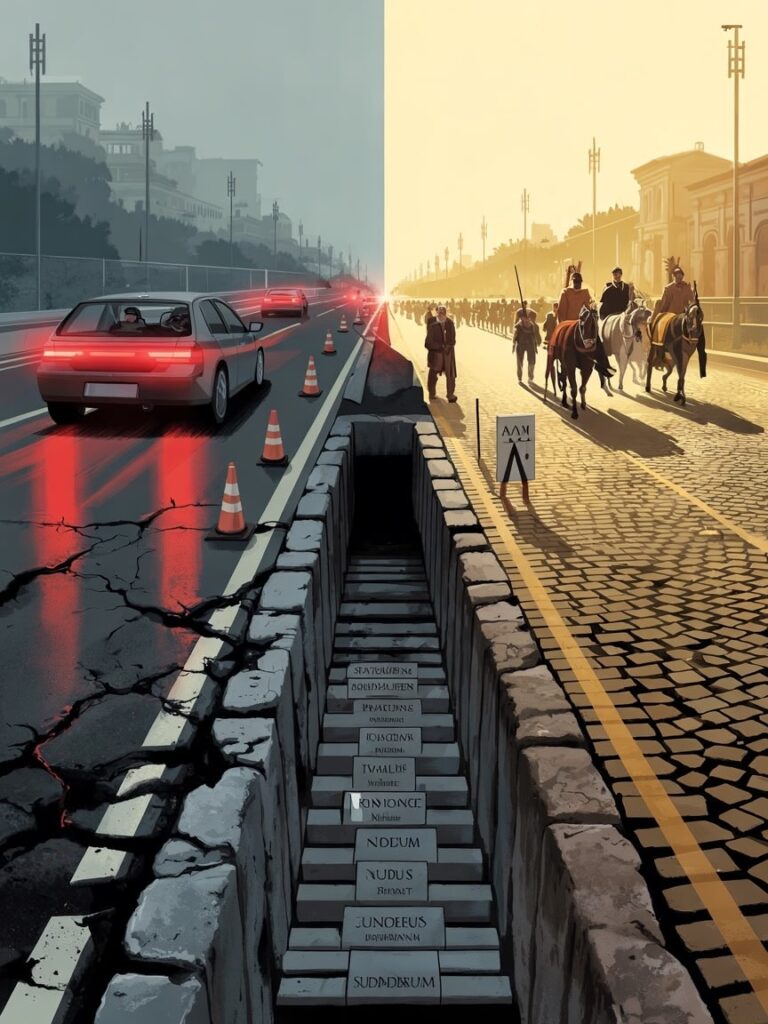
Engineering That Defied Time
What made Roman roads revolutionary wasn’t just their extent but their construction. While modern highways might need repaving every decade or two, many Roman roads have survived two millennia of use, weather, and warfare. Their engineering approach was methodical and standardized across the empire, creating a reliable transportation experience regardless of region.
Roman road construction began with extensive surveying—often creating the remarkably straight paths that characterized their major highways. Roman engineers preferred direct routes whenever possible, cutting through hills and bridging valleys rather than meandering around obstacles. This preference for straight paths wasn’t merely aesthetic; it minimized distance for military movements and commercial transport, increasing the efficiency of imperial operations.
Once surveyors marked the path, workers would dig a trench up to several feet deep. Unlike modern roads that often sit directly on graded earth, Roman roads featured sophisticated layered foundations. The bottom layer, called the statumen, consisted of large stones or rubble that provided drainage and structural stability. Above this came the rudus, a layer of crushed stone or gravel mixed with lime mortar. Next was the nucleus, a finer cement-like layer that further distributed weight. Finally, the surface layer, or summum dorsum, typically featured tightly-fitted polygonal stone pavers on major highways, creating the distinctive Roman road appearance that has survived in numerous archaeological sites.
The Road as Military Machine
Rome’s transportation revolution began with military necessity. The first major Roman highway, the famous Via Appia (Appian Way), was constructed in 312 BCE to move troops rapidly during the Samnite Wars. This strategic investment demonstrated a fundamental understanding that would define Rome’s approach to empire: control of movement equals control of territory.
For legionaries marching across Europe, Africa, and Asia, Roman roads provided predictable travel times, reliable supply lines, and tactical advantages. A Roman legion could march approximately 20 miles per day on these roads, covering distances that would have taken significantly longer on the crude paths used by their adversaries. This mobility transformed Roman military operations, allowing commanders to concentrate forces quickly, respond to threats across vast territories, and maintain control of distant provinces with relatively small garrisons.
The strategic value of Roman roads extended beyond mere speed. Their standardized construction supported heavy military equipment that would bog down on lesser routes. The width of major roads—typically 4-6 meters—allowed troops to march in formation, maintaining military cohesion during movements. Mile markers along the routes enabled precise planning of military campaigns and logistics.
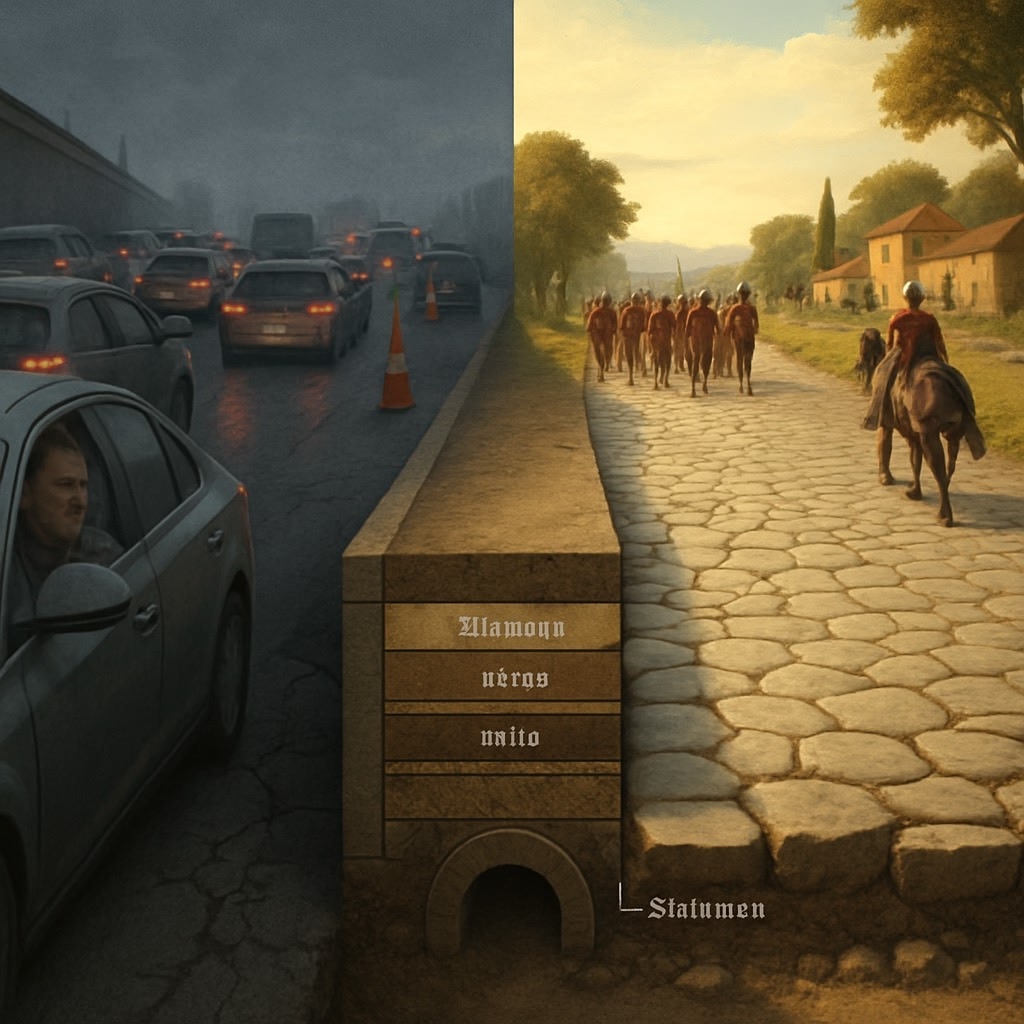
From Military Highways to Economic Arteries
What began as military infrastructure soon transformed into the ancient world’s most sophisticated commercial network. Before Roman roads, overland trade was so difficult and expensive that shipping goods just 75 miles by land could double their cost. The Roman highway system dramatically reduced these costs, enabling unprecedented economic integration across three continents.
Merchants could now transport goods year-round with reasonable predictability. Agricultural products reached urban markets more reliably, reducing food shortages and price volatility in major cities. Luxury goods from distant provinces became more accessible to wealthy Romans, while Roman products found new markets in the empire’s furthest reaches. This commercial revolution wasn’t merely about wealth—it created economic interdependence that bound the empire together as effectively as any legion.
The economic impact of Roman roads extended beyond just the movement of goods. The highway system facilitated labor mobility, allowed for specialized regional production, and created entirely new economic opportunities. Roadside inns, called mansiones and mutationes, emerged at regular intervals to serve travelers. These became important local economic hubs, particularly in rural areas that had previously seen little commercial activity.
The Information Superhighway of Antiquity
Perhaps the most overlooked aspect of the Roman road system was its role in information exchange. Before reliable roads, communication across large territories was painfully slow and unreliable. The cursus publicus, Rome’s official courier service, changed this reality. Using the highway network and a system of relay stations, imperial messengers could cover up to 50 miles per day, carrying official communications, military orders, and administrative directives.
This communication speed created a more responsive governance system than any previous empire had managed. Administrators in Rome could issue directives and receive updates from distant provinces in weeks rather than months. Military commanders could coordinate actions across multiple theaters. Imperial policies could be implemented more uniformly. Information moved with unprecedented speed, binding together an empire of remarkable diversity.
The roads didn’t just carry official communications. They became conduits for cultural exchange, religious movements, and intellectual developments. Christianity spread along Roman highways, with early missionaries following the same routes used by merchants and soldiers. Architectural styles, artistic techniques, and philosophical ideas traveled these same paths, creating cultural connections across vast distances.
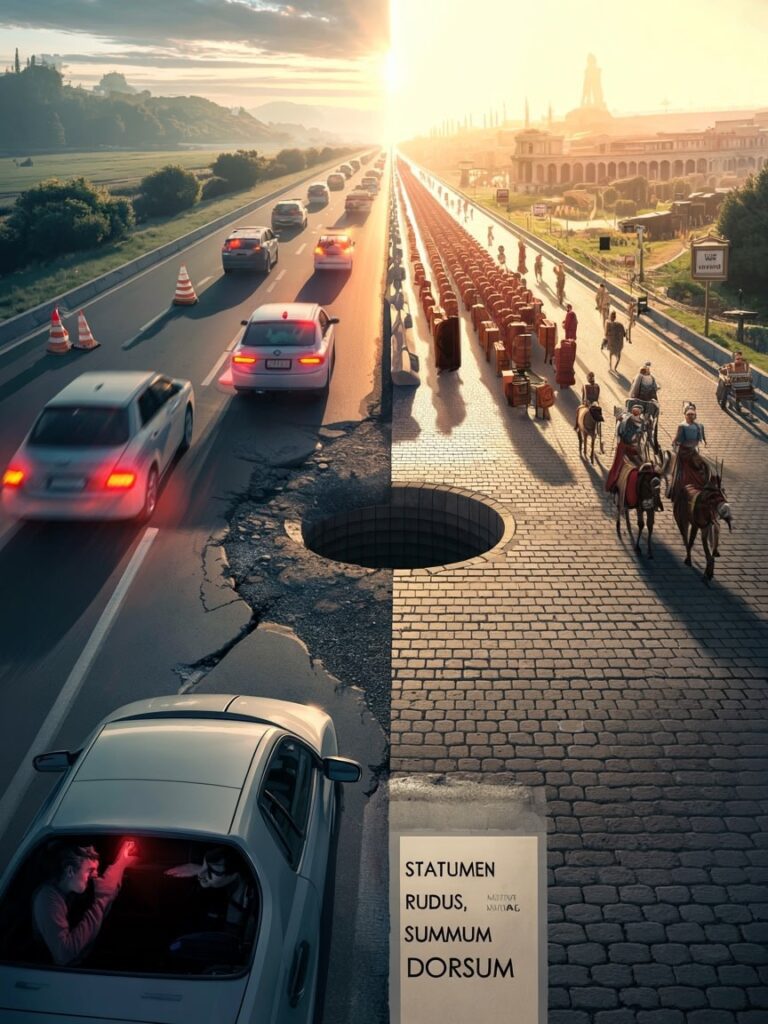
Engineering Solutions That Transformed Landscapes
Roman road builders faced environmental challenges that would daunt modern engineers, yet solved them with remarkable ingenuity using only ancient technology. When confronting mountainous terrain, they constructed switchbacks with precisely calculated grades to make passages manageable for wheeled vehicles. Through marshlands, they built elevated causeways on foundations of oak piles driven into the earth. Across rivers, they erected bridges using innovative arch technology that distributed weight so effectively that many examples still stand today.
The Romans’ approach to water management along their highways was particularly sophisticated. Roads featured crowns (raised centers) that encouraged rainwater to flow toward drainage ditches along the sides. In areas prone to flooding, carefully designed culverts channeled water beneath the roadbed. These drainage systems were maintained with the same diligence as the road surfaces themselves, recognizing that water damage was the greatest threat to transportation infrastructure.
Roman engineers also pioneered tunnel construction for their highways, cutting through mountains when necessary rather than always circumventing them. The Furlo Pass tunnel, carved through the Apennine Mountains in central Italy, remains an impressive example of Roman determination to create direct routes regardless of natural obstacles. At 38 meters long, it allowed the Via Flaminia to pass directly through a mountain rather than navigating a dangerous cliff-side path.
The Social Network of Stone and Mortar
Beyond their military and economic functions, Roman roads fundamentally transformed how people understood distance and community. Before this transportation revolution, most people rarely traveled more than a few miles from their birthplace throughout their entire lives. Cultural and linguistic differences could be dramatic between regions separated by relatively small distances. The road system changed this reality, creating greater mobility for average citizens and connecting previously isolated communities.
The psychological impact of this connectivity shouldn’t be underestimated. For the first time, people throughout the Mediterranean world and beyond could conceive of themselves as part of a unified political entity. The phrase “all roads lead to Rome” wasn’t merely poetic—it reflected a physical reality that shaped how millions of people understood their relationship to imperial power and to each other.
This connectivity also transformed social hierarchies and opportunities. Talented individuals from provincial backgrounds could more easily travel to regional centers or even to Rome itself, seeking education, apprenticeships, or political connections. The empire became more meritocratic as mobility increased, with provincial citizens rising to the highest levels of government, military leadership, and cultural influence.
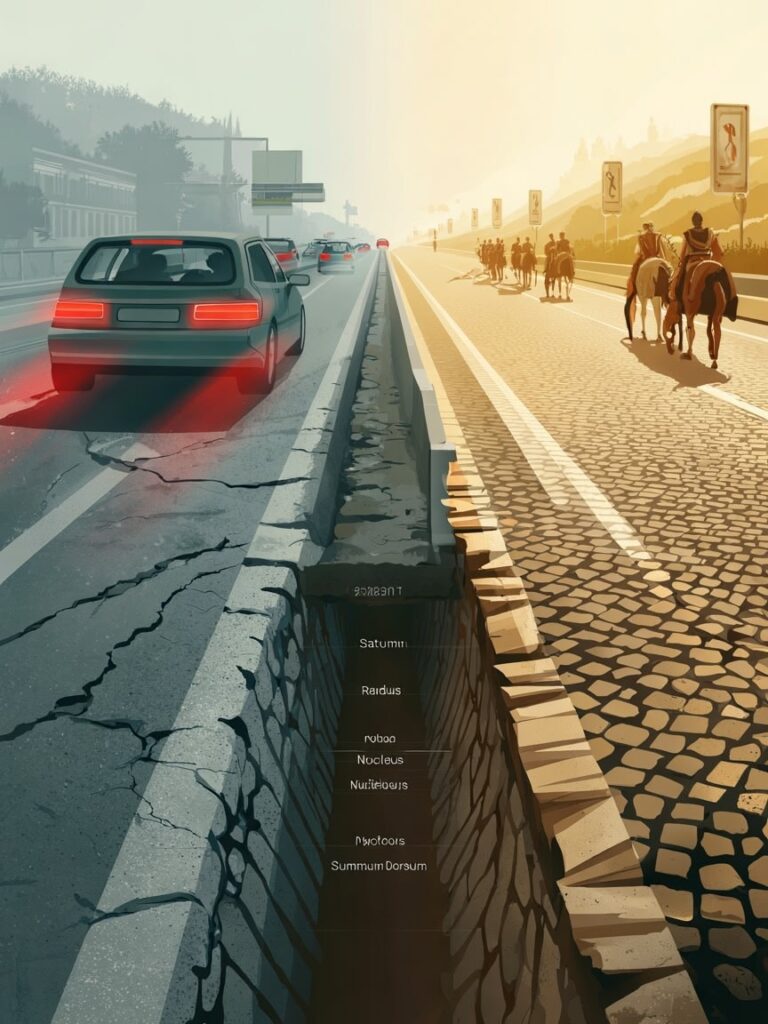
The Price of Progress
The Roman transportation revolution came with significant costs, both literal and metaphorical. Road construction was enormously expensive, requiring vast amounts of labor and materials. Much of this burden fell on provincial populations through taxation and corvée labor requirements. Local communities were often responsible for maintaining sections of highway that passed through their territories, creating ongoing obligations that could strain resources.
The environmental impact was also substantial. Roman road construction required massive deforestation for timber used in bridges, milestones, and construction equipment. Quarrying for stone pavers and foundation materials scarred landscapes across the empire. The very permanence that makes Roman roads engineering marvels also represented a significant environmental modification that altered watersheds, animal migration patterns, and local ecosystems.
Perhaps most significantly, the same roads that brought trade, culture, and administrative efficiency also facilitated military control and resource extraction. For conquered peoples, Roman highways were physical reminders of imperial domination—pathways that brought tax collectors, military reinforcements, and cultural pressures. The connectivity that benefited the imperial system often came at the expense of local autonomy and traditional ways of life.
The Legacy in Our Modern Commute
As you sit in modern traffic, you might not realize how much your experience owes to Roman innovation. Many modern European highways directly follow ancient Roman routes, including parts of Italy’s SS7 (following the Via Appia) and England’s A1 road (following Ermine Street). Even in regions never controlled by Rome, their influence on road design principles remains profound.
The Romans’ layered construction approach continues to influence modern highway engineering. Their emphasis on proper drainage as essential to road longevity remains a fundamental principle in contemporary road building. Even the legal concept of roads as public infrastructure, maintained by government rather than private entities, has its roots in Roman jurisprudence.
Perhaps most importantly, the Romans understood something that modern transportation planners rediscover with each generation: transportation infrastructure isn’t merely about moving from point A to point B—it’s about connecting communities, enabling commerce, strengthening governance, and creating shared experiences. The most successful transportation systems, ancient or modern, recognize that roads are fundamentally social and political infrastructure as much as they are physical constructions.
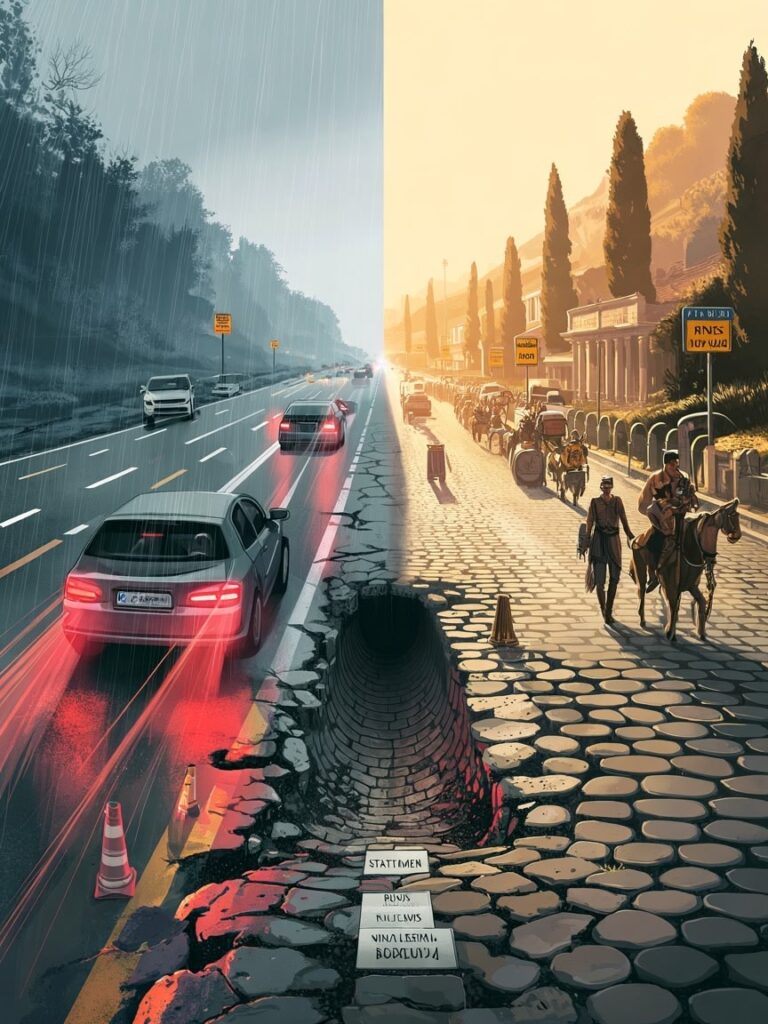
Ancient Solutions to Modern Problems
The Romans faced many of the same transportation challenges we confront today: how to maintain infrastructure over time, how to fund public works that benefit everyone, how to balance directness with environmental impact, and how to create systems that serve multiple purposes simultaneously. Their solutions weren’t perfect, but they were remarkably effective and durable.
As modern societies struggle with crumbling infrastructure, traffic congestion, and the environmental impacts of transportation, the Roman example offers valuable perspective. They demonstrated that transportation investments yield returns across generations, that standardized approaches can create remarkable efficiencies, and that connectivity itself generates value beyond the mere movement of people and goods.
Perhaps most importantly, the Roman road system reminds us that transformative infrastructure requires both technical excellence and political will. Rome’s roads weren’t built by accident or happy coincidence—they represented a sustained commitment to a vision of connectivity that spanned centuries and transcended individual leaders. Each generation of Romans contributed to a transportation legacy that outlived the empire itself.
The Road Forward
The next time your commute stretches beyond patience, consider the journey of a Roman courier traversing the empire on foot or horseback. Despite our frustrations with modern traffic, we inherit a world made smaller by visionary builders who understood that prosperity, security, and civilization itself depend on the connections we create.
Rome’s greatest legacy isn’t in ruins to be admired, but in the fundamental understanding that investment in movement—of people, goods, and ideas—yields returns far beyond the obvious. Their highway system didn’t merely serve an empire; it made an empire possible. As we face our own transportation challenges, from congestion to climate impact, the Roman example reminds us that how we move shapes who we become, both as individuals and societies.
The ancient commute, with its dusty roads and weary travelers, may seem distant from our air-conditioned vehicles and smartphone navigation. Yet the fundamental human desire to move efficiently and connect meaningfully remains unchanged. The Romans understood this truth and built accordingly. Their roads remind us that the best infrastructure doesn’t just serve present needs—it shapes future possibilities.
And perhaps that perspective makes the next traffic jam a bit more bearable.

